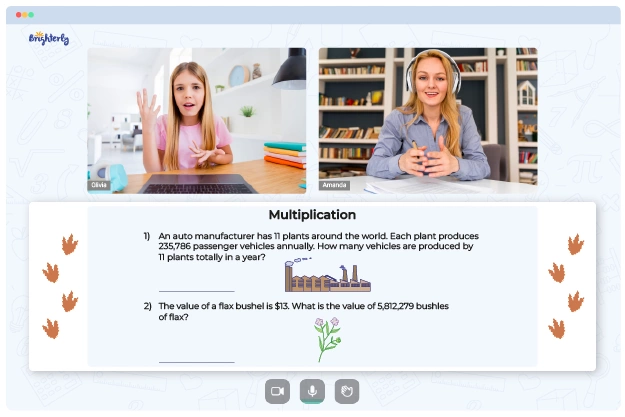Partial Product
Created on Dec 17, 2023
Updated on January 3, 2024
Partial product is a fascinating mathematical concept that serves as the foundation for mastering multiplication and division. At Brighterly, we believe in making math fun and accessible for children, and that’s why we’re breaking down the partial product concept into easy-to-understand pieces. It’s especially important for kids who are just beginning to explore the world of multiplication and division, as it provides them with the tools needed to excel in these essential mathematical operations. Join us in this post, where we’ll dive deep into the world of partial products and help you apply this powerful technique to your mathematical journey.
What is a Partial Product?
Partial product refers to the interim results obtained during the process of multiplication. It’s a method that breaks down a multiplication problem into smaller, more manageable parts. This technique is often used in long multiplication and it helps students to better understand how multiplication works.
Partial Product Definition
In the realm of mathematics, the partial product is an approach used to break down more complex multiplication problems into simpler ones. This is achieved by multiplying each digit of the first number by each digit of the second number separately, and then adding up these ‘partial products’ to get the final result.
Distributive Property of Multiplication
The partial products algorithm is based on the distributive property of multiplication. This property states that the product of a number and the sum of two or more other numbers is equal to the sum of the products of the first number and each of the other numbers. In mathematical terms, for any numbers a, b, and c, a * (b + c) = a * b + a * c. The distributive property is a fundamental principle in arithmetic and algebra.
Product of Two Numbers Using the Partial Product Method
To find the product of two numbers using the partial product method, you first break down the numbers into their place values. Then, you multiply each place value of the first number by each place value of the second number. Finally, you add up all these partial products to get your final result.
Multiplication of a Two-Digit Number with an One-Digit Number
To understand partial product better, let’s take a look at the multiplication of a two-digit number with a one-digit number. For example, consider the multiplication 24 * 3. Here, you’d first break down 24 into 20 and 4. Then, you’d multiply each of these by 3, giving you partial products of 60 and 12. Adding these together gives you the final product of 72.
Multiplication of a Two-Digit Number with a Two-Digit Number
Now, let’s take it a step further with the multiplication of a two-digit number with another two-digit number. For instance, take the problem 12 * 34. You would first break down 12 into 10 and 2, and 34 into 30 and 4. Then, you’d multiply each part of the first number by each part of the second number, getting four partial products: 300, 120, 40, and 8. Adding these together, you get the final product of 408.
Partial Products Division
Just as with multiplication, partial products can also be used in division. This method involves dividing in parts, or chunks, which makes the process easier to understand. It’s especially helpful when dealing with larger numbers.
Solved Examples on Partial Product
-
Example: 23 x 4
Let’s break down 23 into 20 and 3. Now, multiply each of these parts by 4:
- 20 x 4 = 80
- 3 x 4 = 12
Now, add these partial products together:
- 80 + 12 = 92
So, 23 x 4 equals 92.
-
Example: 45 x 36
First, break down 45 into 40 and 5, and 36 into 30 and 6. Then, multiply each part of the first number by each part of the second number:
- 40 x 30 = 1200
- 40 x 6 = 240
- 5 x 30 = 150
- 5 x 6 = 30
Add all these partial products:
- 1200 + 240 + 150 + 30 = 1620
So, 45 x 36 equals 1620.
Practice Problems on Partial Product
-
Problem: 34 x 7
Break down 34 into its place values and multiply each by 7. Then, add those products together to find your answer.
-
Problem: 56 x 43
Break down both numbers into their place values. Then, multiply each part of the first number by each part of the second number. Add up all these partial products to find your final answer.
Remember, practice is key to mastering the partial products method! By consistently working through these problems, you’ll soon find the process of multiplication becoming more straightforward and intuitive.
Conclusion
The partial products method, as taught by the dedicated team at Brighterly, is an incredibly effective and intuitive way to understand and perform multiplication and division. By simplifying complex problems into smaller, more manageable parts, this method fosters a deeper understanding of the fundamental mathematical operations. As children practice and apply the partial products method, they will not only gain confidence in their math skills but also develop a strong foundation for more advanced mathematical concepts. So, embark on this exciting journey with Brighterly and watch your math skills soar!
Frequently Asked Questions on Partial Product
What is a partial product in multiplication?
A partial product in multiplication refers to the product you get when you multiply one digit of a number by another digit of a second number. This is part of the process of breaking down a larger multiplication problem into smaller, easier-to-manage parts.
How do you find the partial product?
To find the partial product, you break down the numbers being multiplied into their place values, then multiply each part of the first number by each part of the second number. You then add up all of these partial products to get your final result. It’s an intuitive process that makes multiplication more manageable.
Why is the partial products method useful?
The partial products method is useful because it simplifies multiplication and helps students understand the logic behind the operation. It’s especially beneficial when dealing with larger numbers, as it breaks down a complex problem into smaller, easier steps.




